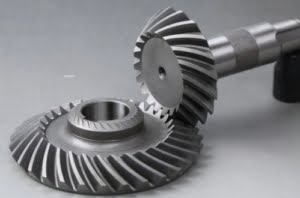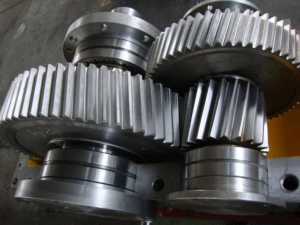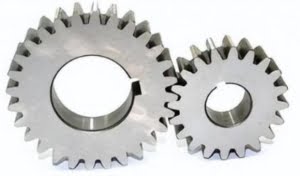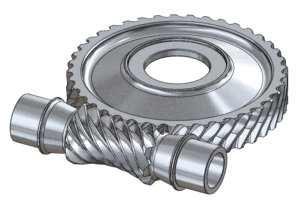Gearbox and Geared Motor Purchase Guide
Gearboxes Types
There are many types of gearbox and geared motor manufactured throughout the world. One of the main differences between individual gearbox and geared motor is their performance characteristics. Choosing from the various gearbox types is application dependent. Gearboxes are available in many sizes, ratios, efficiencies and backlash characteristics. All of these design factors will affect the performance and cost of the gearbox. There are several types of gearboxes:
Bevel Gearboxes

bevel gears

spiral bevel gears
There are two types of bevel gearboxes which include either straight or spiral teeth gears. Straight bevel gears have straight and tapered teeth and are used in applications requiring slow speeds. Spiral bevel gears have curved and oblique teeth and are used in applications requiring high-performance, high speed applications. Bevel gears are typically constructed from cast iron, aluminum alloy or other steel materials but vary between manufacturers. Bevel gearboxes are mainly used in right angle applications with the shafts in a perpendicular arrangement.
Helical Gearboxes

helical gears
Helical gears are cut at angles which allow for gradual contact between each of the helical gear teeth. This type of innovation provides for a smooth and quiet operation. Gearboxes using helical gears are applicable in high horsepower and efficient applications. Helical gears are typically constructed from cast iron, aluminum allow or iron material but may vary depending on the manufacturer. Helical gears are widely used in applications requiring efficiency and high horsepower.
Spur Gearboxes

spur gears
Spur gears are made with straight teeth mounted on a parallel shaft. The noise level of spur gears is relatively high due to colliding teeth of the gears which make spur gear teeth prone to wear. Spur gears come in a range of sizes and gear ratios to meet applications requiring a certain speed or torque output.
Worm Gearboxes

worm gears
Worm gears are able to withstand high shock loads, low in noise level and maintenance-free but are less efficient than other gear types. Worm gears can be used in right angle configuration. The worm gearbox configuration allows the worm to turn the gear with ease; however, the gear cannot turn the worm. The prevention of the gear to move the worm can be used as a braking system. When the worm gearbox is not active, it is held in a locked position. Worm gears are typically constructed of aluminum, stainless steel and cast iron. The material used varies depending on the manufacturer. Worm gears are used in heavy load applications requiring high speeds. These gearboxes can also be configured for right-angle applications.
Planetary Gearboxes

Sun Gear and Planetary Gears
Planetary gearboxes are so named due to their resemblance to the solar system. The components of a planetary gearbox include a sun gear, ring gear and planetary gears. The sun gear is the central gear which is fixed in the center, ring gear (annulus ring) which is the outer ring with inward-facing teeth, and the planetary gears which rotate around the sun gears and mesh with both the sun and ring gear.
Gearmotors
A gearmotor is a combination of an electric motor and a mounted gearbox, integrated into a simple package. A gearmotor combination reduces complexity, saves time in matching components, and lowers costs in designs requiring high torque low speed output. Gearmotors can be manufactured to be integral or be combined as separate components. Gearmotors which have the motor and gear reducer sharing the same shaft is what is meant by integral. Gearmotors are used in many applications and industries, even in everyday household appliances. Industrial applications include cranes, lifts, jacks and conveyor machines. Everyday household appliances gearmotors are used in are washing machines, mixers, clocks, hand tools like drills and dryers.
How to Select the Appropriate Gearbox and geared motor?
When considering a gearbox and geared motor, many factors need to be considered to meet specific application requirements:
Gear Ratio
Gear ratios are defined as the correlation between the number of teeth of two or more different gears. Typically, the number of teeth a gear has is proportional to its circumference. This means that the gear with a larger circumference will have more gear teeth. The relationship between the circumferences of the two gears can also give an accurate gear ratio. For example, if one gear has 36 teeth while another gear has 12 teeth, the gear ratio would be 3:1.
Output Torque
Output torque depends on the gear ratio used. To obtain a high output torque, a high gear ratio should be selected. This will lower the output shaft speed of the motor. Inversely, using a lower gear ratio will result in a smaller output torque value being delivered into the system, with a greater motor speed at the output shaft. This principle illustrates the inversely proportional relationship between torque and speed.
Speed (RPM)
Speed is inversely proportional to the gear ratio of the system. For example, the greater the number of teeth on the output gear, the greater the speed at the output shaft. Conversely, the more gear teeth at the output compared to the input, the lower the speed at the output shaft. In general, the output speed can be determined by dividing the input speed by the gear ratio. The higher the ratio the lower the output speed will be and vice versa.
Gear Arrangement
Gear arrangement offers various benefits over the traditional fixed axis gear system design. The unique combination of both power transmission efficiency and compact size allows for a lower loss in effectiveness. The more efficient the gear arrangement, (i.e. spur, helical, planetary and worm) the more energy will be transmitted and converted into torque, rather than energy lost as heat. Another application factor to be taken into account is load distribution. Since the load being transmitted is shared among multiple planets, the torque capacity is increased. The higher number of planets in a gear system will increase the load ability and enhance torque density. Gear arrangements improve stability and rotational stiffness by creating a balanced system. Other gear arrangements as mentioned in the Types of Gearboxes segment of this guide are bevel, helical, cycloid, spur and worm.
Backlash
Backlash is the angle at which the output shaft of a gearbox and geared motor can rotate without either the input shaft or the gap between the teeth of two adjacent gears moving. It is not necessary to consider backlash for applications which do not involve load reversals, however in precision applications with load reversals (robotics, automation, CNC machines, etc.) backlash is crucial for accuracy and positioning.
Gearbox and Geared Motor Formulas
Motor Torque * Gear Ratio * Efficiency = Output Shaft Torque
Example: Motor Torque = 175 oz-in Gear Ratio = 5:1 Efficiency = 0.95 175 * 5 * 0.95 = 831.25 Output Shaft Torque = 831.25 oz-in
Gearbox Torque = 9550 * Motor Power / Input Shaft Speed * Ratio * Efficiency
Input Torque: T1 = 9550 * P/ n1
Output Torque : T2 = 9550 * P / n2
(Note: Do not take transmission efficiency into consideration) P: input power KW n1= input speed rpm n2= output speed rpm
Input Shaft Speed (RPM) / Gear Ratio = Output Shaft Speed
Example: Input Shaft Speed = 1500 RPM Gear Ratio = 5:1 1500 / 5 = 300 Output Shaft Speed = 300 RPM
Gear Ratio = Teeth on First Gear : Teeth on Second Gear
Example: First gear has 60 teeth Second gear has 20 teeth Gear Ratio 60:20 (reduces to 3:1) Gear Ratio = 3:1
Gear Ratio = Actual Output Torque / 9550 / Motor Power * Input Speed/Service Factor
Motor Power = Torque / 9550 * Input Speed / Gear Ratio / Service Factor
Gearbox Service Factor = Gearbox Rated Power / Motor Power
Gearbox Service Factor = Rated Output torque / Actual Output Torque
Glossary
- Addendum: the height of the gear tooth above the pitch circle diameter
- Backlash: the angle the output shaft of the gearbox can move without the input shaft moving
- Base Circle: an imaginary circle used in involute gearing to generate the involutes that form the tooth profiles
- Bevel Gears: used for right-angle applications. There are two types of bevel gears which are straight and spiral
- Bore: the diameter of the hole in a sprocket, gear, bushing, etc
- Center distance: distance between the axes of two meshed gears
- Circular Thickness: the thickness of the tooth on the pitch circle
- Dedendum: the depth of the tooth below the diameter of the pitch circle
- Diametrical Pitch: the teeth per inch of the diameter of the pitch circle
- Differential Gear: a bevel gear which allows two shafts to rotate at a different speed
- Gear: a wheel with teeth that meshes with another wheel with teeth to translate motion
- Gear Center: the center of the pitch circle
- Gear Ratio: the ratio between the numbers of teeth of meshing gears
- Gear Train: two or more gears meshed by their teeth. A gear train generates power speed through the meshed gears rotating
- Helical Gear: a gear with the gear teeth cut at angles
- Line of Contact: the line or curve along which two tooth surfaces are tangent to each other
- Involute: the curve which describes a line which is unwound from the circumference of the gear
- Pinion: a small cogwheel which fits into a larger gear or track
- Pitch Circle: the curve of intersection of a pitch surface of revolution and a plane of rotation
- Pitch Diameter: the diameter of the pitch circle
- Pitch Radius: the radius of the pitch circle
- Planetary Gears: a system that consists of three main components: the sun gear, ring gear, and two or more planet gears. The sun gear is the located in the center, the ring gear is the outermost gear, and the planet gears are the gears surrounding the sun gear inside the ring gear
- Pressure Angle: the angle between the line of action and the normal to the surface of the tooth
- Spiral Bevel Gears: shafts which are perpendicular to each other and are used in right-angle applications
- Spur Gear: connect parallel shafts which have involute teeth that are parallel to the shaft
- Sun gear: a gearwheel that rotates around its own axis and has other gears (planet gears) that rotate around it
- Torsional Stiffness: the measure of the amount of torque that a radial shaft can sustain during its rotation in a mechanical system
- Working Depth: the max depth a tooth of one gear extends into the tooth gear of mating gear
- Worm Gear: a gear with one or more teeth with screwed threads



